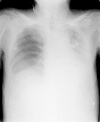Respiratory support with nasal high-flow therapy helps to prevent recurrence of postoperative atelectasis: a case report
- PMID: 25908980
- PMCID: PMC4407315
- DOI: 10.1186/2052-0492-2-3
Respiratory support with nasal high-flow therapy helps to prevent recurrence of postoperative atelectasis: a case report
Abstract
Postoperative atelectasis should be avoided in surgical patients with impaired pulmonary function. Nasal high-flow (NHF) therapy delivered by the Optiflow™ system (Fisher & Paykel Healthcare Ltd., Auckland, New Zealand) is a new, simple device that supplies heated and humidified oxygen gas at >30 L/min via a large-bore nasal cannula. We herein describe a case in which respiratory support with NHF therapy was useful for the prevention of postoperative atelectasis recurrence. A 67-year-old man with an upper digestive tract perforation underwent emergency laparoscopic surgery. He appeared malnourished because of severe untreated diabetes mellitus. The proposed surgery was uneventfully completed. On postoperative day (POD) 5, he experienced massive atelectasis of the left lower lobe with desaturation to <90%. After restoration of normal oxygenation by tracheal suction and postural drainage, noninvasive positive-pressure ventilation (NPPV) at a continuous positive airway pressure (CPAP) of 8 cm H2O was conducted to prevent repeated atelectasis. Fifteen hours after the cessation of NPPV on POD 7, he developed recurrence of massive atelectasis. Bronchoscopic suction removed a mucous plaque in the tracheobronchial tree, and NHF therapy at 40 L/min was subsequently performed, delivering a low level of CPAP instead of NPPV. Under the respiratory support with NHF therapy, his condition was more stable than with NPPV, and his respiratory rehabilitation continued uneventfully. In addition, the NHF therapy delivered optimally humidified gas, which improved the bronchial secretion quality. No further atelectasis occurred throughout the remaining stay in the intensive care unit. We conclude that respiratory support with NHF therapy may contribute to the prevention of postoperative atelectasis by delivering CPAP in combination with progressive respiratory rehabilitation.
Keywords: Atelectasis; Nasal high flow; Postoperative respiratory complication.
Figures
Similar articles
-
Nasal highflow improves ventilation in patients with COPD.Int J Chron Obstruct Pulmon Dis. 2016 May 25;11:1077-85. doi: 10.2147/COPD.S104616. eCollection 2016. Int J Chron Obstruct Pulmon Dis. 2016. PMID: 27307723 Free PMC article. Clinical Trial.
-
Effect of randomization of nasal high flow rate in preterm infants.Pediatr Pulmonol. 2019 Sep;54(9):1410-1416. doi: 10.1002/ppul.24418. Epub 2019 Jul 8. Pediatr Pulmonol. 2019. PMID: 31286694
-
Open-label, phase II study of routine high-flow nasal oxygen therapy in cardiac surgical patients.Br J Anaesth. 2013 Dec;111(6):925-31. doi: 10.1093/bja/aet262. Epub 2013 Aug 6. Br J Anaesth. 2013. PMID: 23921199 Clinical Trial.
-
[Nasal Highflow (NHF): A New Therapeutic Option for the Treatment of Respiratory Failure].Pneumologie. 2016 Jan;70(1):49-54. doi: 10.1055/s-0041-110286. Epub 2016 Jan 20. Pneumologie. 2016. PMID: 26789432 Review. German.
-
Noninvasive Respiratory Support for Postextubation Respiratory Failure.Respir Care. 2019 Jun;64(6):658-678. doi: 10.4187/respcare.06671. Respir Care. 2019. PMID: 31110035 Review.
Cited by
-
High-flow nasal cannula in adults with acute respiratory failure and after extubation: a systematic review and meta-analysis.Respir Res. 2018 Oct 16;19(1):202. doi: 10.1186/s12931-018-0908-7. Respir Res. 2018. PMID: 30326893 Free PMC article.
-
Novel therapies for perioperative respiratory complications.J Cardiovasc Thorac Res. 2017;9(3):121-126. doi: 10.15171/jcvtr.2017.21. Epub 2017 Sep 25. J Cardiovasc Thorac Res. 2017. PMID: 29118943 Free PMC article. Review.
References
Publication types
LinkOut - more resources
Full Text Sources
Other Literature Sources



